When it comes to toilet maintenance, one component that often requires attention is the angle stop valve. Over time, the internals of these valves can deteriorate, leading to leaks or decreased functionality. Fortunately, replacing the guts of a toilet angle stop is a straightforward process that can restore optimal performance and prevent potential water damage. In this article, we will provide a comprehensive guide to help you replace the guts of a toilet angle stop efficiently, offering new ideas and advice to simplify the process and ensure long-lasting results.
Understanding the Angle Stop Valve: The angle stop valve is a vital part of the toilet plumbing system, controlling the flow of water to the toilet tank. It is typically located near the wall behind the toilet and has two components: the valve body and the internal cartridge or stem assembly. Over time, these internal parts may deteriorate, causing leaks or difficulty in shutting off the water supply. Replacing the guts of the angle stop valve involves swapping out the internal components to restore its proper functionality.
Step-by-Step Guide to Replacing the Guts:
- Shut off the water supply: Locate the main water shutoff valve and turn it off to cut off the water supply to the toilet. Flush the toilet to drain any remaining water in the tank and bowl.
- Remove the handle and escutcheon: Unscrew the handle of the angle stop valve and remove the escutcheon plate covering the valve body.
- Remove the bonnet nut: Use an adjustable wrench to loosen and remove the bonnet nut, which secures the valve body to the water supply line.
- Extract the cartridge or stem assembly: Depending on the type of angle stop valve, you may need to unscrew or pull out the cartridge or stem assembly. Carefully remove the old internal components.
- Install the new cartridge or stem assembly: Insert the new cartridge or stem assembly into the valve body, ensuring it fits securely.
- Reassemble and test: Reattach the bonnet nut, handle, and escutcheon plate, tightening them appropriately. Slowly turn on the water supply to the toilet and check for leaks. Make any necessary adjustments to ensure a proper seal.
Choosing High-Quality Replacement Parts
When replacing the guts of a toilet angle stop, it’s crucial to choose high-quality replacement parts to ensure optimal performance and longevity. Look for reputable brands and products that are specifically designed for your type of angle stop valve. Consult with a knowledgeable professional if you’re unsure about compatibility or need expert guidance in selecting the right parts for your toilet.
Maintaining Regular Inspections and Upkeep
While replacing the internals of a toilet angle stop can resolve immediate issues, it’s essential to incorporate regular inspections and maintenance into your routine. Check for any signs of leaks, corrosion, or wear on the valve body, handle, and surrounding connections. Addressing minor issues promptly can prevent major water damage and prolong the lifespan of your angle stop valve.
Consider Professional Assistance
If you’re unfamiliar with plumbing tasks or lack confidence in performing the replacement yourself, it’s always wise to seek professional assistance. Plumbers have the expertise to identify potential complications, ensure proper installation, and provide valuable advice for maintaining your toilet angle stop in optimal condition.
Conclusion:
Replacing the guts of a toilet angle stop is a valuable skill that can save you from potential water damage and ensure the smooth operation of your toilet. By understanding the components involved, following a step-by-step guide, and selecting high-quality replacement parts, you can complete this task with confidence. Regular inspections and maintenance are essential to prevent future issues, and professional assistance is always available if needed. With a well-functioning angle stop valve, you can enjoy a reliable and efficient toilet system while minimizing the risk of water-related mishaps in your home.

